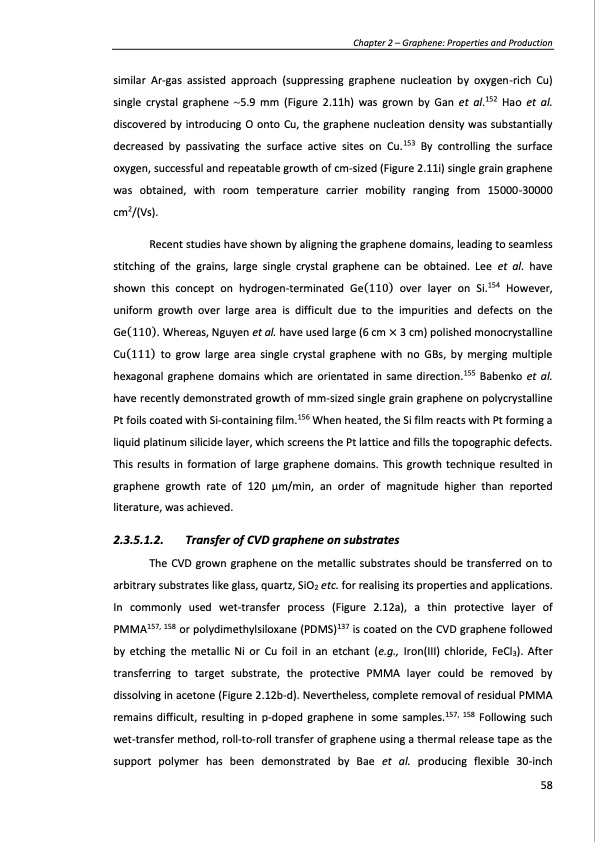
PDF Publication Title:
Text from PDF Page: 058
similar Ar-gas assisted approach (suppressing graphene nucleation by oxygen-rich Cu) single crystal graphene ~5.9 mm (Figure 2.11h) was grown by Gan et al.152 Hao et al. discovered by introducing O onto Cu, the graphene nucleation density was substantially decreased by passivating the surface active sites on Cu.153 By controlling the surface oxygen, successful and repeatable growth of cm-sized (Figure 2.11i) single grain graphene was obtained, with room temperature carrier mobility ranging from 15000-30000 cm2/(Vs). Recent studies have shown by aligning the graphene domains, leading to seamless stitching of the grains, large single crystal graphene can be obtained. Lee et al. have shown this concept on hydrogen-terminated Ge(110) over layer on Si.154 However, uniform growth over large area is difficult due to the impurities and defects on the Ge(110). Whereas, Nguyen et al. have used large (6 cm × 3 cm) polished monocrystalline Cu(111) to grow large area single crystal graphene with no GBs, by merging multiple hexagonal graphene domains which are orientated in same direction.155 Babenko et al. have recently demonstrated growth of mm-sized single grain graphene on polycrystalline Pt foils coated with Si-containing film.156 When heated, the Si film reacts with Pt forming a liquid platinum silicide layer, which screens the Pt lattice and fills the topographic defects. This results in formation of large graphene domains. This growth technique resulted in graphene growth rate of 120 μm/min, an order of magnitude higher than reported literature, was achieved. 2.3.5.1.2. Transfer of CVD graphene on substrates The CVD grown graphene on the metallic substrates should be transferred on to arbitrary substrates like glass, quartz, SiO2 etc. for realising its properties and applications. In commonly used wet-transfer process (Figure 2.12a), a thin protective layer of PMMA157, 158 or polydimethylsiloxane (PDMS)137 is coated on the CVD graphene followed by etching the metallic Ni or Cu foil in an etchant (e.g., Iron(III) chloride, FeCl3). After transferring to target substrate, the protective PMMA layer could be removed by dissolving in acetone (Figure 2.12b-d). Nevertheless, complete removal of residual PMMA remains difficult, resulting in p-doped graphene in some samples.157, 158 Following such wet-transfer method, roll-to-roll transfer of graphene using a thermal release tape as the support polymer has been demonstrated by Bae et al. producing flexible 30-inch Chapter 2 – Graphene: Properties and Production 58PDF Image | PRODUCTION AND APPLICATIONS OF GRAPHENE AND ITS COMPOSITES

PDF Search Title:
PRODUCTION AND APPLICATIONS OF GRAPHENE AND ITS COMPOSITESOriginal File Name Searched:
graphene-production-applications.PDFDIY PDF Search: Google It | Yahoo | Bing
Salgenx Redox Flow Battery Technology: Power up your energy storage game with Salgenx Salt Water Battery. With its advanced technology, the flow battery provides reliable, scalable, and sustainable energy storage for utility-scale projects. Upgrade to a Salgenx flow battery today and take control of your energy future.
| CONTACT TEL: 608-238-6001 Email: greg@infinityturbine.com | RSS | AMP |